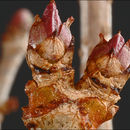Biology
(
Inglês
)
fornecido por Arkive
Elder is a deciduous shrub that grows very quickly. Leaves are present from March through to November and it is in flower from June to July, the berries ripening from August to September (7). The aromatic flowers are pollinated by small flies and other insects (2)
The uses of elder, of leaves, bark, wood, flowers and berries are many and varied. The shrub has been used for centuries as a fast-growing hedgerow plant (6). The hard heart wood was highly valued and the pith, one of the world's lightest natural solids, is still used today for holding small biological specimens in microscopy (4). Hollowed-out stems make excellent pea-shooters and 'guns' for children (4). The leaves have been used to protect livestock from flies, and for various medicinal purposes, including soothing wounds, bruises and headaches. Indeed, elder was something of a cure-all, with every part of the shrub being used to treat a plethora of ills ranging from toothache to the plague. The use of the bark as a purgative dates back to Hippocrates, while today, elder flower water is still used for skin problems and as an eye wash (6). The main surviving uses for elder are culinary. Elder-flower cordial and wine (once known as elder-flower champagne) are still popular today. The berries are made into jellies, jams, syrups, wines, and relishes and the flowers can be battered, fried and eaten as fritters (5).
Conservation
(
Inglês
)
fornecido por Arkive
Conservation action is not required for this species at present.
Description
(
Inglês
)
fornecido por Arkive
The elder is not quite large enough to be classed as a tree, but is too large for a bush (4). It is a strange 'tree' of many contrasts. The heartwood is extremely hard, yet the branches are weak and barely able to support themselves. It produces clumps of creamy-white sweet-smelling flowers (2) but the leaves give off an unpleasant pungent smell, similar to the smell of mice nests, as the alternative name 'God's stinking tree' attests (4). Elder berries are small, globe shaped and a deep purplish-black in colour, and have been harvested for centuries for a huge range of purposes (4). Elder is the focus of a rich wealth of folk lore, and has many magical associations (5). The name 'elder' derives from the Anglo-Saxon word aeld, meaning fire. This may have arisen from the practice of using the hollow stems of the elder as bellows to encourage fires (4) (5). It was, however, extremely bad luck to burn elder wood; if this happened the Devil was said to appear, explaining another local name 'Devil's wood' (5). Conversely it was said to keep the Devil away if planted close to a house (4). Some of these old superstitions linger today; many modern hedge-cutters refuse to attack an elder for fear of bad luck (6). The hollow branches are the origins of yet another (this time Scottish) name 'bour-tree'; bour means pipe (4). The cross used to crucifix Jesus is said to have been made of elder wood, and the elder was tree on which Judas hanged himself (4).
Habitat
(
Inglês
)
fornecido por Arkive
Thrives in disturbed fertile soils in a wide range of habitats including waste ground, roadsides, woods, grassland and railway banks (3). It is very tolerant of rabbit grazing and is a common feature around warrens (2).
Range
(
Inglês
)
fornecido por Arkive
Common throughout Britain with the exception of northern Scotland up to altitudes of 470 m (2) (3) and has been introduced to Orkney and Shetland (2). It is widespread in Europe but becomes scarce in the extreme north. It is also found in western Asia, North Africa and the Azores (2).
Status
(
Inglês
)
fornecido por Arkive
Not threatened (3).
Threats
(
Inglês
)
fornecido por Arkive
The elder is not threatened.

